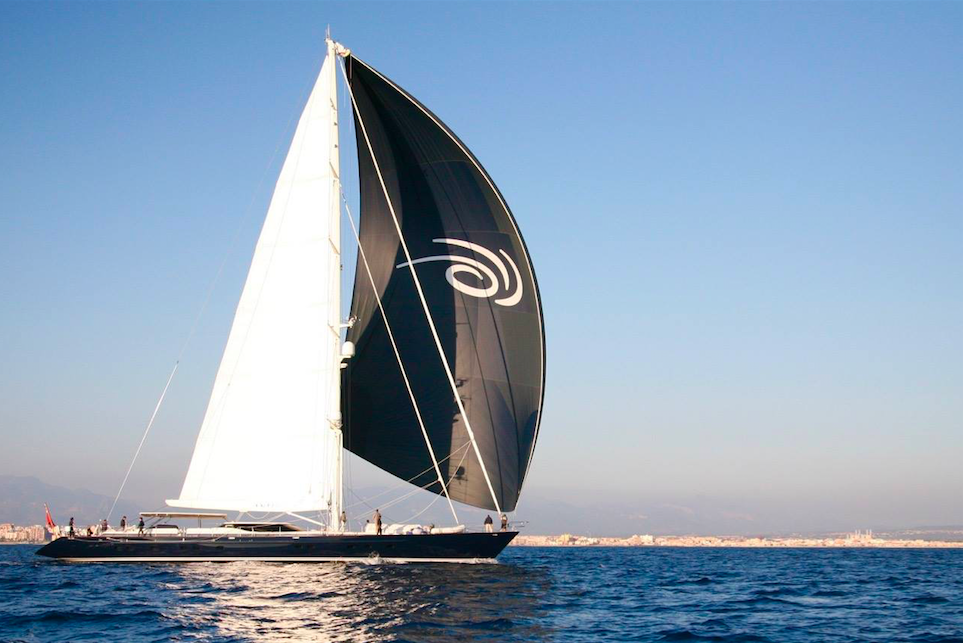During a yacht builders’ symposium which took place in Auckland many years ago, it was decided S.Y. Tenaz (ex Mamamouchi) would be as big as super sail yachts would get. This sloop ‘solely’ measures 40m, which is almost humble nowadays compared to the many sailing giants dominating our seas. Think the Royal Huisman-built 90m three masted schooner Athena, with her 55 captive and drum winches she allows for tacks under full sail in nothing flat. Or the 93m Eos, with her three towering masts she knocked Athena off her number one spot as the biggest sail yacht when she was launched in 2006. And this was ten years ago!
Big boat designer Malcolm McKeon, who was fully involved with the design of the 66m Ahimsa (ex Aglaia), comments that indeed “Twenty years ago, 100 foot was a large sailing yacht. Nowadays 150 foot is considered ‘normal’ in the super yacht world, and anything over 200 foot is pushing limits. As yachts continue to grow, there are more hurdles to overcome trying to increase performance without compromising safety and comfort. However, new technologies are continually being developed which change the boundaries of design possibilities. For example, a system was designed to hoist and retrieve Ahimsa’s sails without the risk of crew injury. This was paramount to making it possible to sail her safely and efficiently.”
And this trend of sail yachts bursting forth raises challenges not only for a designer but also for the riggers and sailmakers involved. 7C Rigging’s Andrew Kitchener -who has been stepping the world’s most sizeable super yacht rigs since 2001- agrees “As a yacht rigging company we have needed to adapt to the industry: this has meant new techniques to safely handle masts and sails of these sizes. Every job takes much longer and thinking outside the box for ways to deal with issues regarding the
halyards and systems onboard is a challenge. I guess since super yachts pushed the 60m rig limits anything easy has become a thing of the past. Nevertheless, these new mega yachts are a giant leap forward.”
Cutting-edge design techniques and the creation of new materials have been enabling designers and builders to push the boat out, literally.
Doyle, at the forefront of super sail making technology, not only supply Stratis ICE sails – an impressive 30% lighter than their all-carbon counterparts – but are also the first to introduce sail art. By means of giant digital printers and a unique process they can create designs which are part of the actual cloth: no paint has to be manually drawn up on the material. The outcome is a stronger and, again, lighter sail.
Contemporary boat building construction has culminated in extraordinary yachts like the 66.7m Hetairos, the biggest boat built in carbon, resulting her to weigh as much as the 38m ‘petite’ performance Perini P2. Hetairos took line honours in the
Transatlantic Superyacht Regatta & Maxi Yacht Cup in 2011, proving she’s not only plenteous but also a force to be reckoned with on the race course.
All these vanguard ‘inventions’ have propelled size limits to new heights, more than 100m heights to be precise, as the world’s largest masts, weighing a whopping 50 tonnes per rig, were made for Sailing Yacht A. Each of her three masts have been created to cope with bending loads more than double that of a Boeing Dreamliner Wing. (1) The boom vang alone had to be designed to hold up to 400 tonnes and one of the main sails is twice the size of the aforementioned ‘Aglaia’. The build of this 140m mammoth, the largest sail yacht currently ruling our seas, not only grants owner
Melnichenko bonafide bragging rights, but has also been called “a monument of invention”. (2)
Kitchener agrees that it’s a technological step forward and, “You bet”, it’s pushed the boundaries, but “would you want to get the sail down in a 35knt rain squall at 04.00am? Hell no!” Kitchener adds that “When loads are reached in excess of 30-50 ton it takes a great deal of skill for the crew to handle these sails safely.” Doyle Palma’s head of design, Quinny Houry, agrees that ‘When sails went over half a ton they went over crew handling sizes. Safety factors have to be far greater as you can’t have a failure at sea with only ten crew to deal with a sail the size of a swimming pool.”
There are other ground-breaking builds in the making
Moreover, this 140m sailing yacht, not very long ago unthinkable, is not even that exceptional as there are other ground-breaking builds in the making as we speak: the 141m mega sail yacht Dream Symphony, taking shape in Turkey and looking to out-size Sail Yacht A. Another is the 108m super yacht SOLAR, in build at Dutch yard Oceanco. Houry is expecting the 60-70 m range to become the next generation of ‘normal’ sailing super yachts.
McKeon also sees there being more of these large sailing yachts in the future: “As sailing yachts are perceived as being more “green” than motor yachts and owners become more ecologically aware and prefer to be seen to limit their environmental impact while still being able to retain the comfort and speed of a similarly sized motor yacht.”
Kitchener says that he is not sure where this will end, “Carbon fibre seems to have no limit, if it is bigger then make it thicker, sailmakers seem to keep finding new ways to stitch enough cloth to make the sail, rigging manufacturers are extending sheds to keep going higher, naval architects have no limit to the size of paper to draw on, and owner’s check-books are not bouncing yet. While we have people who say we can design it, build it, sail it, and sell it, then onward and upward.”
But how much do these new breed of boats still fulfil the traditional idea of a sailing yacht? Will we put those walloping 200.000 Euro sails up while crossing the Atlantic or would we rather not take the risk of breakage, (and having to give the owner some very bad news), and thus prefer to spend 50.000 on diesel instead? Can we sail them confidently in anything over 25/30 knots? Could they deal with a 50 knot squall? In short: are these boats all show and no go, mere motor yachts with a mast on top for which ‘sailing’ translates to turning the engine on while putting the storm jib up? Yachts that only hoist those ginormous sails so they can star in a heli-photo shoot while idling along at nothing more than 4-5 knots?
Perhaps, but Houry throws in that 15 years ago a 45m sail boat was a complete compromise. “You wouldn’t even think about sailing a 45m boat but now there is a whole fleet of fast-paced yachts capable of top speeds and slick sailing manoeuvres, like for example the 46m Dubois- designed sloop ‘Ganesha’”! Granted, her regatta results include wins at St.Barths, Sardinia and Palma: she’s known for cleaning up on the race course. So, will we one day see 140m monsters able to perform on par with the ‘Ganeshas’ on the circuit today? Houry says that he has no doubt in his mind.
This article was first published by The Breeze Studio, a PR, digital and social media agency specialising in communication and content for the yachting and aviation
industries. http://breeze-studio.co.uk
By: Danielle Berclouw
Notes:
All photography courtesy of Doyle Palma, with grateful thanks.
(1) yachtingworld.com: World’s biggest masts are finished for the world’s biggest sailing superyacht by Elaine Bunting
(2) Dailymail.co.uk: The superyacht with masts taller than BIG BEN’s tower and sails the size of a football field: Russian billionaire designs luxury vessel set to begin sea trials later this year
















0 Comments